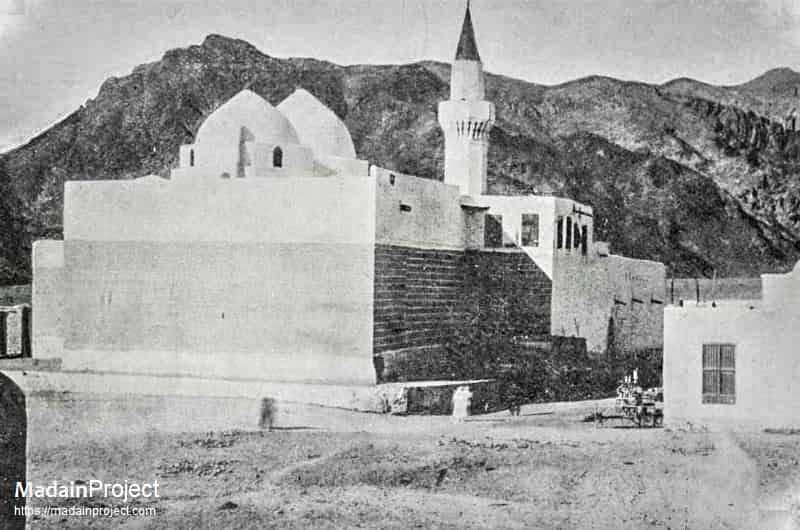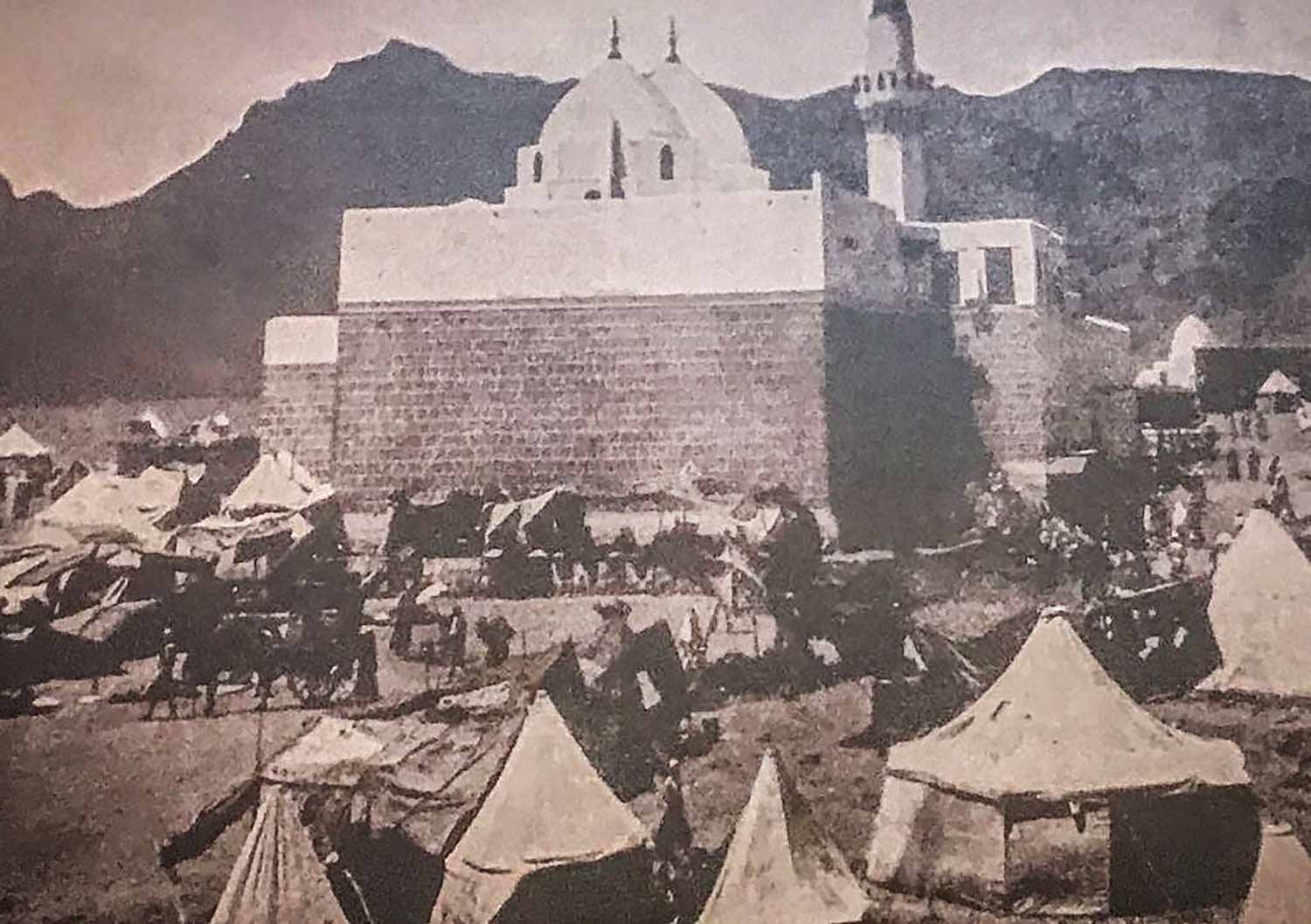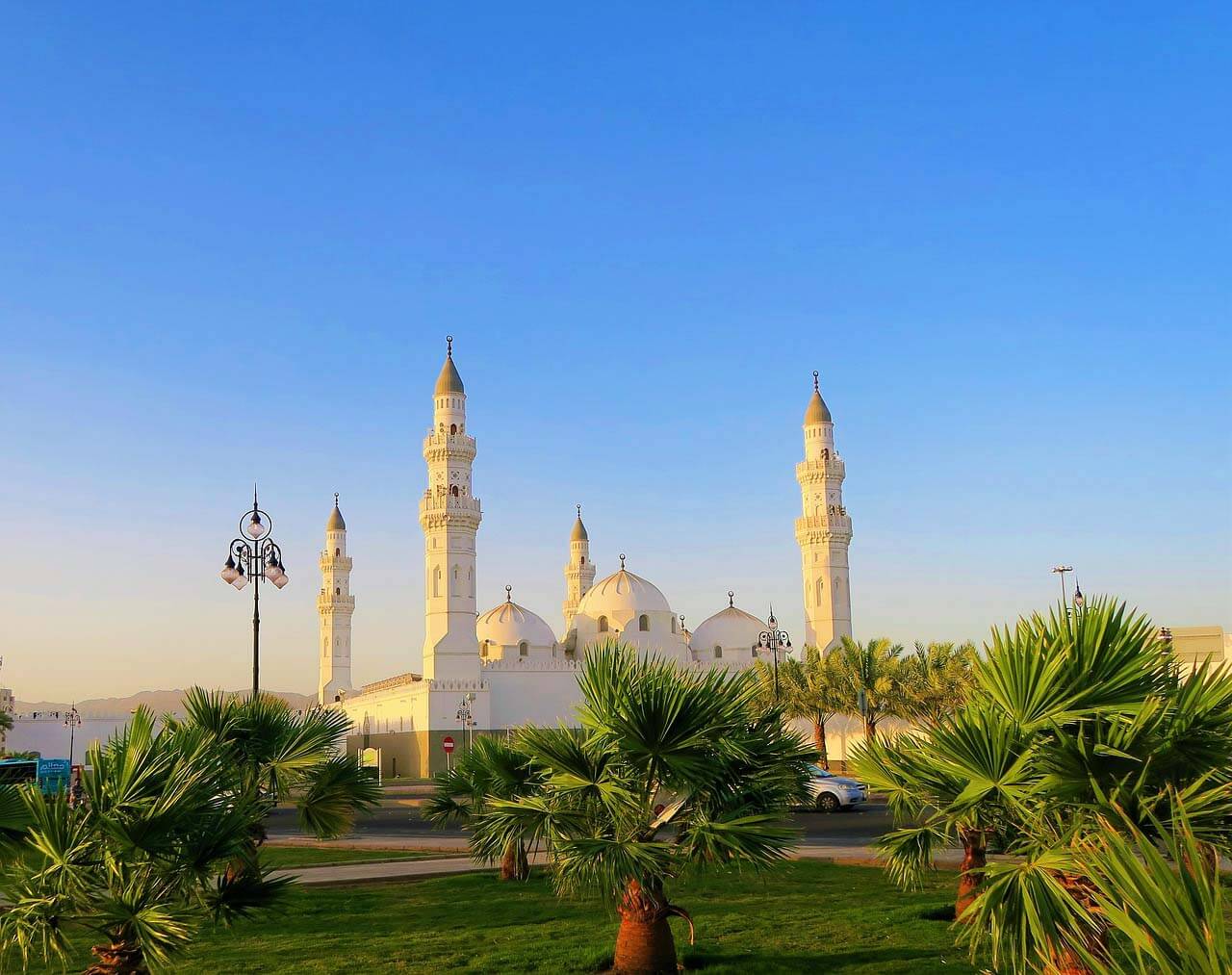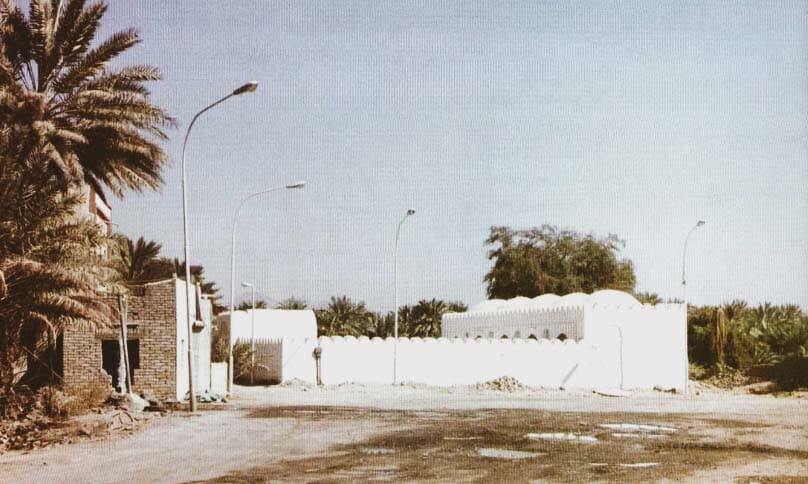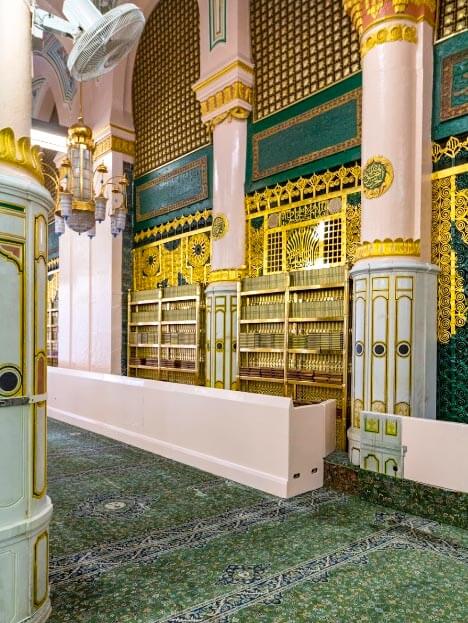Medina Sharif, Saudi Arabia
Coordinates: 24.467239, 39.613821
First Photograph
- House of sorrow
- Mausoleum of four Imams
- Daughters of the Prophet ﷺ
- Wives of the Prophet ﷺ
- Hz. Aqil and Hz. Abullah ibn Jafar رضي الله عنهم
- Hz. Malik and Hz. Nafie
- Hz. Ibrahim رضي الله عنه, the little son of the Prophet ﷺ
- Bibi Halimah al-Sadiah رضي الله عنها
- Bibi Fatimah Bint Asad رضي الله عنها
- Hz. Uthman رضي الله عنه, the third Caliph.
Demolitions in Al Baqi Cemetery
Al-Baqi cemetery, the oldest and one of the two most important Islamic graveyards located in Medina, in current-day Saudi Arabia, was demolished in 1806 and, following reconstruction in the mid-19th century, was destroyed again in 1925 or 1926.
An alliance of the House of Saud, and the followers of the Wahhabi movement known as the Emirate of Diriyah, carried out the first demolition. The Sultanate of Nejd, also ruled by the House of Saud and followers of Wahhabism, carried out the second. In both cases, the actors were motivated by the Wahhabi interpretation of Islam, which prohibits the building of monuments on graves.
Mausoleum of four Imams along with Abbas ibn Abd al-Muttalib.
Baqi al-Gharqad (the field of thorny trees), also known as Jannat al-Baqi , was used as a cemetery before the advent of Islam.
The most famous person buried at al-Baqi during the lifetime of Hz. Prophet Muhammad ﷺ, was his infant son Hz. Ibrahim رضي الله عنه. Many narrations attest that Hz. Prophet Muhammad ﷺ visited this cemetery regularly to pray for God’s forgiveness for those buried there.
It gained further attention after the first companion of Hz. Prophet Muhammad ﷺ, Hz. Uthman ibn Maz’un رضي الله عنه was buried there in 625.
Also Hz. Hasan ibn Ali رضي الله عنه, Hz. Ali ibn Husayn رضي الله عنه, Hz. Muhammad al-Baqir رضي الله عنه, and Hz. Jafar al-Sadiq رضي الله عنه were also buried there making it an important location for both Sunni and Shia Muslims.
Historical records show that there were domes, cupolas, and mausoleums in Jannat al-Baqi before the 20th century; today it is a bare land without any buildings.
Formation of Saudi Wahhabi State
An alliance between Muhammad ibn Abd al-Wahhab and Muhammad ibn Saud led to the formation the first Saudi State (also known as the Emirate of Diriyah), challenging the authority of the Ottoman Empire.
Most of the Najd was under Ibn Saud’s control by the time Muhammad bin Saud died in 1765. By 1806, the Hijaz, including Mecca and Medina, was under the control of the Sauds. The expansion of Wahhabi movement came at the expense of the Ottoman empires’ losing the control over Islam’s holy places.
Consequently, the Ottoman Empire sent armies and defeated the first Saudi state in the Ottoman–Wahhabi War (1811–1818). Years later in 1924–1925, the Saud clan regained control over Hijaz and the Kingdom of Hejaz and Nejd was formed under Abdul Aziz ibn Saud’s rule.
Wahhabis tried to carry out the demolition within a legal religious context since they regarded the shrines as “idolatrous” and believed that marking graves is Bid’a based on their interpretation of Qur’anic verses regarding graves and shrines which were rejected by all sunni and shia scholars worldwide.
They drew from the story of the golden calf found in the Qur’an where Israelites manufactured idols and prayed to them causing God to become angry.
On the other hand, many scholars used a number of different verses and traditions to support the practice of building shrines over the graves of Islamic saints. According to Shia scholar Mohammad Jafar Tabasi, the graves of Shia Imams buried in al-Baqi had been revered for hundreds of years and none of the Sunni scholars (ulamas) regarded the shrines as innovation.
Weeks before the second demolition, at the request of Ibn Bulayhid, a group of fifteen scholars from Medina unanimously issued a fatwa (an Islamic legal ruling) condemning the making of mausoleums around the graves.
Demolitions
First demolition
At the beginning of the House of Saud’s nineteenth century (1806) control over Mecca and Medina, they demolished many of the religious buildings including tombs and mosques, whether inside or outside the Baqi, in accordance with their doctrine. These were razed to the ground, and plundered for their decorations and goods.
After taking control of the holy cities, the Saudis tried to create obstacles to prevent non-Wahhabi Muslims from performing the Hajj (annual pilgrimage). In the next few years, they gradually increased the Hajj duty. They also banned pilgrims from bringing musical instruments and mahmal (richly decorated palanquins) – both often brought by pilgrims but incompatible with Wahhabi religious standards, and later “boys or other beardless persons”.
In 1805, a year before the destruction, Iraqi and Iranian Muslims were not allowed to perform Hajj. Syrians and Egyptians were refused permission to perform Hajj in 1806 and 1807. Maghrebi Muslims were not prevented from performing the hajj.
The Ottoman Sultan Mahmud II, ordered the governor of Egypt, Muhammad Ali Pasha, to retake the territories controlled by the Wahhabi rebels, starting the Ottoman–Wahhabi War. Muhammad Ali Pasha’s son, Ibrahim Pasha, defeated the rebel clans at the Battle of Diriyah in 1818. By the order of Sultan Mahmud the Ottomans built and renovated buildings, domes, and mosques in “splendid aesthetic style” from 1848 to 1860.
Sir Richard Francis Burton, who visited Medina in 1853 disguised as an Afghan Muslim named “Abdullah”, said that there were fifty-five mosques and shrines after the reconstruction by the Ottomans. Another English adventurer visiting Medina in 1877–1878, described the city as a “small beautiful city resembling Istanbul”. He mentions its “white walls, golden slender minarets and green fields”. Also, Ibrahim Rifat Pasha, an Egyptian official travelling between 1901 and 1908, described sixteen domes marking individual and/or a collection of graves.
Second demolition
The House of Saud regained control of Hijaz in 1924 (or 1925). The following year Ibn Saud granted permission to destroy the site with religious authorization provided by Qadi Abd Allah ibn Bulayhid; the demolition began on 21 April 1926 (or 1925) by the Ikhwan (“Brothers”), a Wahhabi religious militia.
The demolition included destroying even the simplest gravestones. British convert Eldon Rutter compared the demolition to an earthquake: “All over the cemetery nothing was to be seen but little indefinite mounds of earth and stones, pieces of timber, iron bars, blocks of stone, and a broken rubble of cement and bricks, strewn about.”
The workers destroying the buildings received 1,000 Majidi Riyal, the unit of currency at the time.
Reactions
Both Sunni and Shia Muslims protested against the destruction and rallies are held annually in India, Pakistan, Iran, and the United States. The day is regarded as Yaum-e Gham (“Day of Sorrow”) by many Shias.
According to the Encyclopaedia Islamica, prominent Sunni theologians and intellectuals have condemned the “unfit” situation of the al-Baqi cemetery but the Saudi authorities have so far ignored all criticism and rejected any requests for restoration of the tombs and mausoleums.
List of Sited Demolished in Medina Sharif Province
Medina Sharif
Jannat al-Baqi in Medina, leveled, still open access for men. Women are advised against visiting cemeteries in wahhabism.
The Mosque of al-Manaratain in Medina.
Mosque and tomb of Sayyid Imam al-Uraidhi ibn Ja‘far al-Sadiq رضي الله عنه, destroyed by dynamite on August 13, 2002.
Four mosques at the site of the Battle of the Trench in Medina.
The Mosque of Abu Rasheed.
Hz. Salman al-Farsi رضي الله عنه Mosque, in Medina.
Raj’at ash-Shams Mosque, in Medina.
Grave of Hz. Hamida al-Barbariyya رضي الله عنها, the mother of Hz. Imam Musa al-Kadhim رضي الله عنه
House of Prophet Muhammad ﷺ in Medina, where he lived after the migration from Mecca.
Tomb and Mosque of Hamzah ibn Abdul Muttalib, originally built during the reign of al-Nasir li-Din Allah it was later renovated during Ottoman era, most likely in mid-ninteenth century. The tomb abcutally belongs to two individuals Hamzah ibn Abdul Muttalib and his nephew Abdullah ibn Jahash, after they were martyred in Uhud. It was demolished during the demolitions campaign of 1926 and the complex was divided in two seperate structures, Uhud Martyrs enclave and Sayed al Shohada Mosque.
House of Hz. Ali رضي الله عنه where Hz. Hasan رضي الله عنه and Hz. Husayn رضي الله عنه were born.
Qubbat’ al-Thanaya, the burial site of Prophet Muhammad ﷺ incisor that was broken in the Battle of Uhud.
Bayt al-Ahzan of Sayyida Fatima رضي الله عنها, in Medina.
House of Imam Ja’far al-Sadiq رضي الله عنه, in Medina.
Mashrubat Umm Ibrahim, built to mark the location of the house where Prophet Muhammad’s ﷺ son, Hz. Ibrahim رضي الله عنه, was born to Mariah.


